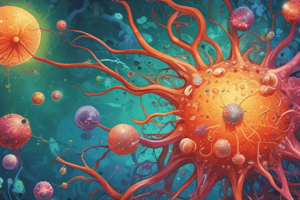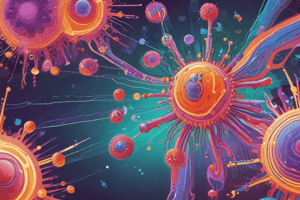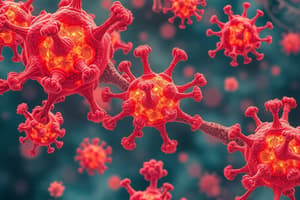Podcast
Questions and Answers
What initiates the adaptive immune response?
What initiates the adaptive immune response?
- MHC molecules
- Antigen presentation (correct)
- Zoonosis
- The presence of antibodies
What is the primary function of Antigen Presenting Cells (APCs)?
What is the primary function of Antigen Presenting Cells (APCs)?
- To generate herd immunity
- To destroy pathogens directly
- To produce antibodies
- To present antigens to T cells (correct)
Which of the following statements best describes a characteristic of the adaptive immune response?
Which of the following statements best describes a characteristic of the adaptive immune response?
- It is very specific and has memory. (correct)
- It has a quick response but no memory.
- It operates independently of antigens.
- It is a non-specific response.
Where do T cells mature within the immune system?
Where do T cells mature within the immune system?
What type of immunity arises from the presence of antibodies in the bloodstream?
What type of immunity arises from the presence of antibodies in the bloodstream?
What does the term 'zoonosis' refer to in the context of the immune system?
What does the term 'zoonosis' refer to in the context of the immune system?
Which statement correctly defines an antigen?
Which statement correctly defines an antigen?
What type of cells does the lymphoid lineage primarily give rise to?
What type of cells does the lymphoid lineage primarily give rise to?
What distinguishes active immunity from passive immunity?
What distinguishes active immunity from passive immunity?
What type of anti-venom would neutralize the venom of several snake species?
What type of anti-venom would neutralize the venom of several snake species?
Who is credited with the first development of a vaccine?
Who is credited with the first development of a vaccine?
What is the purpose of a vaccine?
What is the purpose of a vaccine?
What defines an epidemic?
What defines an epidemic?
What is the primary goal of herd immunity?
What is the primary goal of herd immunity?
Which term describes a pandemic?
Which term describes a pandemic?
What is the meaning of R0 in epidemiology?
What is the meaning of R0 in epidemiology?
What is the primary function of antibodies?
What is the primary function of antibodies?
What are the components of an antibody?
What are the components of an antibody?
Which major histocompatibility complex (MHC) class is associated with the humoral response?
Which major histocompatibility complex (MHC) class is associated with the humoral response?
Which type of T cell is identified by the CD8+ marker?
Which type of T cell is identified by the CD8+ marker?
How are B cells primarily activated in the immune response?
How are B cells primarily activated in the immune response?
What is the role of memory cells in the immune response?
What is the role of memory cells in the immune response?
Which antibody type is primarily involved in the initial immune response against pathogens?
Which antibody type is primarily involved in the initial immune response against pathogens?
What characteristic defines the hypervariable regions of an antibody?
What characteristic defines the hypervariable regions of an antibody?
How does the Major Histocompatibility Complex (MHC) influence tissue graft acceptance?
How does the Major Histocompatibility Complex (MHC) influence tissue graft acceptance?
What is the primary distinction between MHC class I and class II?
What is the primary distinction between MHC class I and class II?
What term describes the constant presence of a disease within a specified geographical area at low prevalence?
What term describes the constant presence of a disease within a specified geographical area at low prevalence?
Compared to endemic diseases, what characterizes hyperendemic diseases?
Compared to endemic diseases, what characterizes hyperendemic diseases?
What does R0 (R Zero) represent in epidemiology?
What does R0 (R Zero) represent in epidemiology?
Which of the following diseases has the highest mortality rate among infected cases?
Which of the following diseases has the highest mortality rate among infected cases?
Which disease is an example of a zoonosis?
Which disease is an example of a zoonosis?
What factor contributes to the emergence of novel pathogens?
What factor contributes to the emergence of novel pathogens?
How is lethality measured concerning infectious diseases?
How is lethality measured concerning infectious diseases?
Which R0 value indicates a pathogen with a higher transmission rate?
Which R0 value indicates a pathogen with a higher transmission rate?
Flashcards
Adaptive Immune Response
Adaptive Immune Response
A specific immune response that involves memory cells to recognize and combat pathogens.
Antigen
Antigen
A molecule that triggers an immune response by binding to specific receptors on immune cells (T and B cells).
Antigen Presenting Cells (APC)
Antigen Presenting Cells (APC)
Cells that present foreign antigens to T cells, initiating the adaptive immune response.
Epitope
Epitope
Signup and view all the flashcards
Antibody
Antibody
Signup and view all the flashcards
MHC (Major Histocompatibility Complex)
MHC (Major Histocompatibility Complex)
Signup and view all the flashcards
Vaccine
Vaccine
Signup and view all the flashcards
Herd Immunity
Herd Immunity
Signup and view all the flashcards
What is an epitope?
What is an epitope?
Signup and view all the flashcards
What is an antibody?
What is an antibody?
Signup and view all the flashcards
What is the humoral response?
What is the humoral response?
Signup and view all the flashcards
What is MHC?
What is MHC?
Signup and view all the flashcards
How are MHC Class 1 and MHC Class 2 different?
How are MHC Class 1 and MHC Class 2 different?
Signup and view all the flashcards
What is a cytotoxic T cell (Tc)?
What is a cytotoxic T cell (Tc)?
Signup and view all the flashcards
What is a helper T cell (Th)?
What is a helper T cell (Th)?
Signup and view all the flashcards
What are lymphocytes?
What are lymphocytes?
Signup and view all the flashcards
What is a B cell?
What is a B cell?
Signup and view all the flashcards
What is clonal selection?
What is clonal selection?
Signup and view all the flashcards
Endemic
Endemic
Signup and view all the flashcards
Hyperendemic
Hyperendemic
Signup and view all the flashcards
R0
R0
Signup and view all the flashcards
Lethality
Lethality
Signup and view all the flashcards
Novel Pathogen
Novel Pathogen
Signup and view all the flashcards
Zoonosis
Zoonosis
Signup and view all the flashcards
Sylvatic Cycle
Sylvatic Cycle
Signup and view all the flashcards
Active Immunity
Active Immunity
Signup and view all the flashcards
Passive Immunity
Passive Immunity
Signup and view all the flashcards
Epidemiology
Epidemiology
Signup and view all the flashcards
SIR Model
SIR Model
Signup and view all the flashcards
R Zero
R Zero
Signup and view all the flashcards
Allergy
Allergy
Signup and view all the flashcards
Study Notes
Defensive Strategies -2: The Adaptive Immune Response
- The adaptive immune response is highly specific and has memory, distinct from the innate response.
- It is triggered by antigen presentation.
- Antigen-presenting cells (APCs) play a crucial role in initiating the adaptive response.
- Antigens, along with epitopes (the active part of the antigen), are involved.
- Antibodies are produced as part of the response.
- Major Histocompatibility Complex (MHC) class 1 and 2 molecules are essential components.
- Vaccines stimulate immunity.
- Herd immunity is a concept related to the collective protection of a population.
- Novel pathogens and zoonotic diseases are important considerations.
Adaptive Immune Response -Cells
- Lymphocytes (T and B cells) are derived from the lymphoid line (differentiated from myeloid line).
- T cells mature in the thymus.
- B cells mature in the bone marrow.
- Helper T cells play a key role in organizing both cellular (cytotoxic T lymphocytes) and humoral responses (through B cells).
T Cells
- T cells are derived from the thymus.
- Two basic types are helper T cells (Th cells) and cytotoxic T cells (Tc cells).
- Th cells are marked by CD4+.
- Tc cells are marked by CD8+.
- Helper T cells are critical coordinators of the adaptive immune response, though vulnerable to attack by HIV, the Human Immunodeficiency Virus.
B Cells
- B cells originate in bone marrow and mature there.
- They produce humoral responses, including plasma cells and memory cells.
- Plasma cells, the effector cells, produce antibodies.
- Memory cells provide a long-lasting response to repeated encounters with the same antigen.
- Plasma cells have a short lifespan, undergoing apoptosis (programmed cell death).
Antigens and Epitopes
- Antigens are molecules that react with preformed antibodies.
- Most antigens are proteins, both intrinsic and extrinsic.
- Epitopes are the portions of antigens that antibodies bind to.
Antibodies
- Antibodies are soluble molecules produced in response to antigens.
- Their key property is the ability to bind specifically to the antigen that prompted their production.
- Antibody-antigen complexes are formed.
- Antibodies are also known as immunoglobulins (Ig).
- There are five antibody classes: IgG, IgM, IgA, IgD, and IgE. Each has a distinct role in immune responses.
MHC Molecules
- MHC (Major Histocompatibility Complex) molecules are crucial for presenting antigens to T cells.
- MHC class 1 molecules present intrinsic (internal) antigens.
- MHC class 2 molecules present extrinsic (external) antigens.
- MHC molecules are involved in tissue typing and graft acceptance.
Response to Pathogens
- The body has responses (cellular and humoral) to intrinsic (intracellular) and extrinsic (extracellular) pathogens, activating different cell types.
Definitions
- R₀ (pronounced R-naught) is the basic reproduction number.
- It represents the average number of secondary infections caused by one infected individual in a wholly susceptible population. This number is indicative of a pathogen's transmissibility.
- Vaccination efforts aim to reduce R₀ below 1.
Vaccine
- Vaccine is a microbial antigen preparation (inactivated or weakened) to stimulate immunity.
- Edward Jenner developed the first vaccine to protect against smallpox.
- Several diseases have been significantly reduced due to vaccines (notably smallpox).
Herd Immunity
- Herd immunity occurs when a substantial portion of the population is immune to a pathogen, protecting those individuals who cannot be vaccinated.
- A high herd immunity level controls the spread of infectious disease.
Epidemics
- Epidemics involve a sudden increase in the prevalence (incidence) of a disease.
- Prevalence is the proportion of infected individuals in a group.
- Severity can be measured by factors including mortality rates, R₀, and herd immunity levels.
Zoonoses
- Zoonoses are diseases transferable from animals to humans.
- Many emerging infectious diseases are zoonotic in origin.
- Zoonotic transmission occurs through various methods.
Other Aspects of Immunity
- Factors relating to vaccine technology, epidemiology, and transmission patterns are part of studying immunity.
Studying That Suits You
Use AI to generate personalized quizzes and flashcards to suit your learning preferences.




